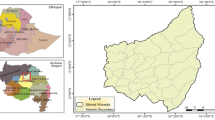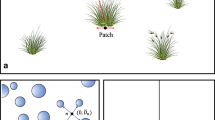Abstract
Soil arthropod communities can provide valuable information regarding the impacts of human disturbances on ecosystem structure. Our study evaluated the structure, composition and diversity of soil meso–micro arthropod communities, in six different vegetation types and assessed the impacts of human activity. A completely randomized design, including 3 replicates from 6 sites (mowing steppe, natural grassland, severe degradation grassland, farmland, artificial shelter forest, and wetland) was used. Soil samples from the depth of 0 to 20 cm were collected during May, July, and September 2007. Soil meso–micro arthropod were separated using the Tullgren funnels method, and were identified and counted. Soil pH value, organic matter, and total nitrogen were measured in topsoil (0–20 cm) from each site. A total of 5,602 soil meso–micro arthropod individuals were collected, representing 4 classes, 14 orders, and 57 families. Most soil arthropods were widely distributed; however, some species appeared to be influenced by environment variables, and might serve as bioindicators of adverse human impacts. Canonical correspondence analysis indicated the soil arthropod distribution in the severely degraded grassland, mowing steppe, farmland, and shelter forest differed from the natural grassland. Arthropod density and diversity were greatest in May, and the forestland community was the most stable. Because of the vital role soil arthropods have in maintaining a healthy ecosystem, mechanisms to maintain their abundance and diversity should be further evaluated.





Similar content being viewed by others
References
Andrea R (1998) A maturity index for predatory soil mites (Mesostigmata: Gamasina) as an indicator of environmental impacts of pollution on forest soils. Appl Soil Ecol 9:447–452
Åslund MW, Simpson MJ, Simpson AJ, Zeeb BA, Rutter A (2012) Earthworm metabolomic responses after exposure to aged PCB contaminated soils. Ecotoxicology 21:1947–1956
Barrett JE, Virginia RA, Wall DH, Adams B (2008) Decline in a dominant invertebrate species contributes to altered carbon cycling in a low-diversity soil ecosystem. Glob Change Biol 14:1734–1744
Beaudouin R, Dias V, Bonzom JM, Péry A (2012) Individual-based model of Chironomus riparius population dynamics over several generations to explore adaptation following exposure to uranium-spiked sediments. Ecotoxicology 21:1225–1239
Butler JL, Gotelli NJ, Ellison AM (2008) Linking the brown and green: nutrient transformation and fate in the sarracenia microecosystem. Ecology 89(4):898–904
Díaz S, Hector A, Wardle DA (2009) Biodiversity in forest carbon sequestration initiatives: not just a side benefit. Curr Opin Environ Sustain 1:55–60
Heemsbergen DA, Berg MP, Loreau M, Van Hal JR, Faber JH, Verhoef HA (2004) Biodiversity effects on soil processes explained by interspecific functional dissimilarity. Science 306:1019–1020
Hooper DU, Bignell DE, Brown VK, Brussaard L, Dangerfield JM, Wall DH, Wardle DA, Coleman DC, Giller KE, Lavelle P, Van der Putten WH, De Ruiter PC, Rusek J, Silver WL, Tiedje JM, Wolters V (2000) Interactions between aboveground and belowground biodiversity in terrestrial ecosystems: patterns, mechanisms, and feedbacks. Bioscience 50:1049–1061
Illig J, Norton RA, Scheu S, Maraun M (2010) Density and community structure of soil-and bark-dwelling microarthropods along an altitudinal gradient in a tropical montane rainforest. Exp Appl Acarol 25:49–62
Jubileus MT, Theron PD, van Rensburg L, Maboeta MS (2013) Utilizing Eisenia andrei to assess the ecotoxicity of platinum mine tailings disposal facilities. Ecotoxicology 22:331–338
Kardol P, Reynolds WN, Norby RJ, Classen AT (2011) Climate change effects on soil microarthropod abundance and community structure. Appl Soil Ecol 47:37–44
Kooijman SALM (1995) The stoichiometry of animal energetics. J Theor Biol 177:139–149
Liao CH, Li JX, Huang HT (1997) Soil animal community diversity in the forest of the southern subtropical region. China Acta Ecol Sinica 17(5):549–555
Lin RL, Buijse L, Dimitrov MR, Dohmen P, Kosol S, Maltby L, Roessink I, Sinkeldam JA, Smidt H, Wijingaarden RPA, Brock TCM (2012) Effects of the fungicide metiram in outdoor freshwater microcosms: responses of invertebrates, primary producers and microbes. Ecotoxicology 21:1550–1569
Lu RK (2000) Analytical methods of soil and agro-chemistry. China Agricultural Science and Technology Press, Beijing
Macfadyen A (1953) Notes on methods for the extraction of small soil arthropods. J Anim Ecol 22:65–77
Margalef R (1958) Temporal succession and spatial heterogeneity in phytoplankton//Traverso B. University of California Press, Berkeley, pp 323–347
Nielsen UN, Osler GHR, Campbell CD, Burslem DFRP, Van der Wal R (2010) The influence of vegetation type, soil properties and precipitation on the composition of soil mite and microbial communities at the landscape scale. J Biogeogr 37:1317–1328
Norton DC, Niblack TL (1991) Biology and ecology of nematodes. In: Nickle WR (ed) Manual of agricultural nematology. Marcel Dekker Inc., New York, pp 47–71
Panikov NS (1999) Understanding and prediction of soil microbial community dynamics under global change. Appl Soil Ecol 11:161–176
Pieluo EC (1996) The measure of diversity in different types of biological collections. J Theor Biol 13:131–144
Rouifed S, Handa IT, David JF, Hättenschwiler S (2010) The importance of biotic factors in predicting global change effects on decomposition of temperate forest leaf litter. Oecologia 163:247–256
Shannon CE, Weaver W (1949) The mathematical theory of communication. University of Illinois Press, Chicago, p 117
Shen PP, Zhou H, Lai HY, Gu JD (2006) Benthic infaunal composition and distribution at an intertidal wetland mudflat. Water Air Soil Pollut Focus 6:575–581
Shen PP, Zhou H, Zhao Z, Yu XZ, Gu JD (2012) Evaluation of sampling sizes on the intertidal macroinfauna assessment in a subtropical mudflat of Hong Kong. Ecotoxicology 21:1706–1716
Simpson EH (1949) Measurement of diversity. Nature 163:688
Van Straalen NM (1997) Community structure of soil arthropods as bioindicator of soil health. In: Pankhurst C, Doube BM, Gupta VVSR (eds) Biological indicators of soil health. CAB International, UK, pp 235–264
Wall DH, Bradford MA, John MG, Trofymow JA, Behan-Pelletier V, DE Bignell, Dangerfield JM, Parton WJ, Rusek J, Voigt W, Wolters V, Gardel HZ, Ayuke FO, Bashford R, Beljakova OI, Bohlen PJ, Brauman A, Flemming S, Henschel JR, Johnson DL, Jones TH, Kovarova M, Kranabetter JM, Kutny L, Lin KC, Maryati M, Masse D, Pokarzhevskii A, Rahman H, Sabará MG, Salamon JA, Swift MJ, Varela A, Vasconcelos H, White D, Zou XM (2008) Global decomposition experiment shows soil animal impacts on decomposition are climate-dependent. Glob Change Biol 14:2661–2677
Wall DH, Bardgett RD, Kelly EF (2010) Biodiversity in the dark. Nat Geosci 3:297–298
Wang DN, Zang SY (2007) Research on the dynamic change of wetland landscape of Daqing city based on RS and GIS. Geomat Spat Inf Technol 30(5):28–32
Wardle DA, Bardgett RD, Klironomos JN, Setälä H, Van der Putten WH, Wall DH (2004) Ecological linkages between aboveground and belowground biota. Science 304:1629–1633
Yin WY (1998) Pictorial keys to soil animals of China. Science Press, Beijing, pp 1–650
Yu Q, Chen Q, Elser JJ, He N, Wu H, Zhang G, Wu J, Bai Y, Han X (2010) Linking stoichiometric homoeostasis with ecosystem structure, functioning and stability. Ecol Lett 13:1390–1399
Zang SY, Huang X, Zheng SF (2005) Landscape processing response analysis on landuse development trend of natural resources based city: a case study in Daqing city. Acta Ecol Sinica 25(7):1699–1706
Zhang LM, Zhang XP (2007) Diversity of macro soil animal in Harbin. For Eng 23:8–10
Zhu XY, Gao BJ, Yuan SL, Hu YC (2010) Community structure and seasonal variation of soil arthropods in the forest-steppe ecotone of the mountainous region in Northern Hebei, China. J Mt Sci-engl 7:187–196
Żmudzki S, Laskowski R (2012) Biodiversity and structure of spider communities along a metal pollution gradient. Ecotoxicology 21:1523–1532
Acknowledgments
The project was financially supported by the National Natural Science Foundation of China (Nos. 41101048; 41371072), the Postdoctoral Science Foundation of China (No. 2013M541407), the Postdoctoral Science Foundation of Heilongjiang Province, Municipal Science Foundation of Harbin (No. 2011RFXXN039) and Program for the Science and Technology Innovation Team in Universities and Colleges of Heilongjiang Province.
Conflict of interest
The authors declare that they have no conflict of interest.
Author information
Authors and Affiliations
Corresponding author
Rights and permissions
About this article
Cite this article
Zhang, L., Zhang, X. & Cui, W. Relationship between land use pattern and the structure and diversity of soil meso–micro arthropod community. Ecotoxicology 23, 707–717 (2014). https://doi.org/10.1007/s10646-014-1186-x
Accepted:
Published:
Issue Date:
DOI: https://doi.org/10.1007/s10646-014-1186-x




